Spontaneous Mutation in the Movement Protein of Citrus Leprosis Virus C2, in a Heterologous Virus Infection Context, Increases Cell-to-Cell Transport and Generates Fitness Advantage
Abstract
:1. Introduction
2. Materials and Methods
2.1. DNA Manipulation
2.2. Inoculation of P12 Plants and Protoplasts for Analysis of Cell-to-Cell Movement, Systemic Spread, or RNA Accumulation
2.3. Northern Blot and Tissue Print Assays
2.4. Statistical and In Silico Analysis
2.5. Viral Fitness Assay
3. Results
3.1. Constructs Harboring CiLV-C2 MP Prevail over CiLV-C MP Constructs in Competition Experiments
3.2. The New Variants of the CiLV-C2 MP Carrying Phenylalanines at 72 and 259 Positions Do Not Increase Significantly Viral Replication
3.3. The Point Mutation S259F Favors a More Efficient Cell-to-Cell Transport
3.4. CiLV-C2WT vs. Mutated MPs
4. Discussion
Supplementary Materials
Author Contributions
Funding
Institutional Review Board Statement
Informed Consent Statement
Data Availability Statement
Acknowledgments
Conflicts of Interest
References
- Dorokhov, Y.L.; Sheshukova, E.V.; Byalik, T.E.; Komarova, T.V. Diversity of Plant Virus Movement Proteins: What Do They Have in Common? Processes 2020, 8, 1547. [Google Scholar] [CrossRef]
- Heinlein, M.; Epel, B.L. Macromolecular Transport and Signaling Through Plasmodesmata. Int. Rev. Cytol. 2004, 235, 93–164. [Google Scholar] [CrossRef] [PubMed]
- Ding, B. Intercellular protein trafficking through plasmodesmata. In Protein Trafficking in Plant Cells; Springer: Berlin/Heidelberg, Germany, 1998; pp. 279–310. [Google Scholar] [CrossRef]
- Lucas, W.J. Plant viral movement proteins: Agents for cell-to-cell trafficking of viral genomes. Virology 2006, 344, 169–184. [Google Scholar] [CrossRef] [PubMed] [Green Version]
- Navarro, J.A.; Sanchez-Navarro, J.A.; Pallas, V. Key checkpoints in the movement of plant viruses through the host. Adv. Virus Res. 2019, 104, 1–64. [Google Scholar] [PubMed]
- Melcher, U. The ‘30K’ superfamily of viral movement proteins. J. Gen. Virol. 2000, 81, 257–266. [Google Scholar] [CrossRef] [PubMed]
- Niehl, A.; Heinlein, M. Cellular pathways for viral transport through plasmodesmata. Protoplasma 2011, 248, 75–99. [Google Scholar] [CrossRef]
- Mushegian, A.R.; Elena, S.F. Evolution of plant virus movement proteins from the 30K superfamily and of their homologs integrated in plant genomes. Virology 2015, 476, 304–315. [Google Scholar] [CrossRef] [PubMed] [Green Version]
- Taliansky, M.; Torrance, L.; Kalinina, N.O. Role of Plant Virus Movement Proteins. Methods Mol. Biol. 2008, 451, 33–54. [Google Scholar] [CrossRef]
- Lewandowski, D.J.; Adkins, S. The tubule-forming NSm protein from Tomato spotted wilt virus complements cell-to-cell and long-distance movement of Tobacco mosaic virus hybrids. Virology 2005, 342, 26–37. [Google Scholar] [CrossRef] [PubMed] [Green Version]
- Wolf, S.; Lucas, W.J.; Deom, C.M.; Beachy, R.N. Movement Protein of Tobacco Mosaic Virus Modifies Plasmodesmatal Size Exclusion Limit. Science 1989, 246, 377–379. [Google Scholar] [CrossRef]
- Fajardo, T.V.M.; Peiró, A.; Pallás, V.; Sanchez-Navarro, J.A. Systemic transport of Alfalfa mosaic virus can be mediated by the movement proteins of several viruses assigned to five genera of the 30K family. J. Gen. Virol. 2013, 94, 677–681. [Google Scholar] [CrossRef] [PubMed] [Green Version]
- Sanchez-Navarro, J.A.; Carmen Herranz, M.; Pallas, V. Cell-to-cell movement of Alfalfa mosaic virus can be mediated by the movement proteins of Ilar-, bromo-, cucumo-, tobamo- and comoviruses and does not require virion formation. Virology 2006, 346, 66–73. [Google Scholar] [CrossRef] [PubMed] [Green Version]
- Freitas-Astua, J.; Ramos-Gonzalez, P.L.; Arena, G.D.; Tassi, A.D.; Kitajima, E.W. Brevipalpus-transmitted viruses: Parallelism beyond a common vector or convergent evolution of distantly related pathogens? Curr. Opin. Virol. 2018, 33, 66–73. [Google Scholar] [CrossRef]
- Bastianel, M.; Novelli, V.M.; Kitajima, E.W.; Kubo, K.S.; Bassanezi, R.B.; Machado, M.A.; Freitas-Astúa, J. Citrus Leprosis: Centennial of an Unusual Mite–Virus Pathosystem. Plant Dis. 2010, 94, 284–292. [Google Scholar] [CrossRef] [PubMed] [Green Version]
- Roy, A.; Choudhary, N.; Guillermo, L.M.; Shao, J.; Govindarajulu, A.; Achor, D.; Wei, G.; Picton, D.D.; Levy, L.; Nakhla, M.K.; et al. A Novel Virus of the Genus Cilevirus Causing Symptoms Similar to Citrus Leprosis. Phytopathology 2013, 103, 488–500. [Google Scholar] [CrossRef] [Green Version]
- Roy, A.; Hartung, J.S.; Schneider, W.L.; Shao, J.; Leon, G.; Melzer, M.J.; Beard, J.J.; Otero-Colina, G.; Bauchan, G.R.; Ochoa, R.; et al. Role Bending: Complex Relationships Between Viruses, Hosts, and Vectors Related to Citrus Leprosis, an Emerging Disease. Phytopathology 2015, 105, 1013–1025. [Google Scholar] [CrossRef] [Green Version]
- Leon, M.G.; Becerra, C.H.; Freitas-Astua, J.; Salaroli, R.B.; Kitajima, E.W. Natural Infection of Swinglea glutinosa by the Citrus leprosis virus Cytoplasmic Type (CiLV-C) in Colombia. Plant Dis. 2008, 92, 1364. [Google Scholar] [CrossRef]
- Leastro, M.O.; Freitas-Astúa, J.; Kitajima, E.W.; Pallás, V.; Sánchez-Navarro, J.A. Membrane Association and Topology of Citrus Leprosis Virus C2 Movement and Capsid Proteins. Microorganisms 2021, 9, 418. [Google Scholar] [CrossRef]
- Pallas, V.; Garcia, J.A. How do plant viruses induce disease? Interactions and interference with host components. J. Gen. Virol. 2011, 92, 2691–2705. [Google Scholar] [CrossRef] [PubMed]
- Li, W.; Lewandowski, D.J.; Hilf, M.E.; Adkins, S. Identification of domains of the Tomato spotted wilt virus NSm protein involved in tubule formation, movement and symptomatology. Virology 2009, 390, 110–121. [Google Scholar] [CrossRef] [Green Version]
- Margaria, P.; Anderson, C.T.; Turina, M.; Rosa, C. Identification of Ourmiavirus 30K movement protein amino acid residues involved in symptomatology, viral movement, subcellular localization and tubule formation. Mol. Plant Pathol. 2016, 17, 1063–1079. [Google Scholar] [CrossRef] [PubMed] [Green Version]
- García, J.A.; Pallás, V. Viral factors involved in plant pathogenesis. Curr. Opin. Virol. 2015, 11, 21–30. [Google Scholar] [CrossRef]
- Takeshita, M.; Suzuki, M.; Takanami, Y. Combination of amino acids in the 3a protein and the coat protein of Cucumber mosaic virus determines symptom expression and viral spread in bottle gourd. Arch. Virol. 2001, 146, 697–711. [Google Scholar] [CrossRef] [PubMed]
- Zhao, W.; Ji, Y.; Wu, S.; Ma, X.; Li, S.; Sun, F.; Cheng, Z.; Zhou, Y.; Fan, Y. Single amino acid in V2 encoded by TYLCV is responsible for its self-interaction, aggregates and pathogenicity. Sci. Rep. 2018, 8, 3561. [Google Scholar] [CrossRef] [PubMed] [Green Version]
- Wobbe, K.K.; Akgoz, M.; Dempsey, D.A.; Klessig, D.F. A Single Amino Acid Change in Turnip Crinkle Virus Movement Protein p8 Affects RNA Binding and Virulence on Arabidopsis thaliana. J. Virol. 1998, 72, 6247–6250. [Google Scholar] [CrossRef] [PubMed] [Green Version]
- Choi, S.K.; Palukaitis, P.; Min, B.E.; Lee, M.Y.; Choi, J.K.; Ryu, K.H. Cucumber mosaic virus 2a polymerase and 3a movement proteins independently affect both virus movement and the timing of symptom development in zucchini squash. J. Gen. Virol. 2005, 86, 1213–1222. [Google Scholar] [CrossRef]
- Peiro, A.; Canizares, M.C.; Rubio, L.; Lopez, C.; Moriones, E.; Aramburu, J.; Sanchez-Navarro, J. The movement protein (NSm) of Tomato spotted wilt virus is the avirulence determinant in the tomato Sw-5 gene-based resistance. Mol. Plant Pathol. 2014, 15, 802–813. [Google Scholar] [CrossRef]
- Wang, H.-L.; Wang, Y.; Giesman-Cookmeyer, D.; Lommel, S.A.; Lucas, W.J. Mutations in Viral Movement Protein Alter Systemic Infection and Identify an Intercellular Barrier to Entry into the Phloem Long-Distance Transport System. Virology 1998, 245, 75–89. [Google Scholar] [CrossRef] [PubMed] [Green Version]
- Wieczorek, P.; Obrępalska-Stęplowska, A. A single amino acid substitution in movement protein of tomato torrado virus influences ToTV infectivity in Solanum lycopersicum. Virus Res. 2016, 213, 32–36. [Google Scholar] [CrossRef]
- Leastro, M.O.; Kitajima, E.W.; Silva, M.S.; Resende, R.O.; Freitas-Astúa, J. Dissecting the Subcellular Localization, Intracellular Trafficking, Interactions, Membrane Association, and Topology of Citrus Leprosis Virus C Proteins. Front. Plant Sci. 2018, 9, 1299. [Google Scholar] [CrossRef] [Green Version]
- Locali-Fabris, E.C.; Freitas-Astua, J.; Souza, A.A.; Takita, M.A.; Astúa-Monge, G.; Antonioli-Luizon, R.; Rodrigues, V.; Targon, M.L.P.N.; Machado, M.A. Complete nucleotide sequence, genomic organization and phylogenetic analysis of Citrus leprosis virus cytoplasmic type. J. Gen. Virol. 2006, 87, 2721–2729. [Google Scholar] [CrossRef]
- Pascon, R.C.; Kitajima, J.P.; Breton, M.C.; Assumpcao, L.; Greggio, C.; Zanca, A.S.; Okura, V.K.; Alegria, M.C.; Camargo, M.E.; Silva, G.G.; et al. The complete nucleotide sequence and genomic organization of Citrus Leprosis associated Virus, Cytoplasmatic type (CiLV-C). Virus Genes 2006, 32, 289–298. [Google Scholar] [CrossRef] [PubMed]
- Leastro, M.O.; Freitas-Astúa, J.; Kitajima, E.W.; Pallás, V.; Sánchez-Navarro, J.A. Unravelling the involvement of cilevirus p32 protein in the viral transport. Sci. Rep. 2021, 11, 1–18. [Google Scholar] [CrossRef] [PubMed]
- Van Dun, C.M.; van Vloten-Doting, L.; Bol, J.F. Expression of alfalfa mosaic virus cDNA1 and 2 in transgenic tobacco plants. Virology 1988, 163, 572–578. [Google Scholar] [CrossRef]
- Sanchez-Navarro, J.A.; Miglino, R.; Ragozzino, A.; Bol, J.F. Engineering of Alfalfa mosaic virus RNA 3 into an expression vector. Arch. Virol. 2001, 146, 923–939. [Google Scholar] [CrossRef] [PubMed]
- Aparicio, F.; Pallas, V.; Sanchez-Navarro, J.A. Implication of the C terminus of the Prunus necrotic ringspot virus movement protein in cell-to-cell transport and in its interaction with the coat protein. J. Gen. Virol. 2010, 91, 1865–1870. [Google Scholar] [CrossRef] [PubMed] [Green Version]
- Taschner, P.E.; Van Der Kuyl, A.C.; Neeleman, L.; Bol, J.F. Replication of an incomplete alfalfa mosaic virus genome in plants transformed with viral replicase genes. Virology 1991, 181, 445–450. [Google Scholar] [CrossRef]
- Loesch-Fries, L.S.; Jarvis, N.P.; Krahn, K.J.; Nelson, S.E.; Hall, T.C. Expression of Alfalfa Mosaic virus RNA 4 cDNA transcripts in Vitro and in Vivo. Virology 1985, 146, 177–187. [Google Scholar] [CrossRef]
- Pallás, V.; Más, P.; Sánchez-Navarro, J.A. Detection of Plant RNA Viruses by Nonisotopic Dot-Blot Hybridization. Methods Mol. Biol. 1998, 81, 461–468. [Google Scholar] [CrossRef]
- Saánchez-Navarro, J.; Fajardo, T.; Zicca, S.; Pallaás, V.; Stavolone, L. Caulimoviridae Tubule-Guided Transport Is Dictated by Movement Protein Properties. J. Virol. 2010, 84, 4109–4112. [Google Scholar] [CrossRef] [Green Version]
- Leastro, M.O.; Castro, D.Y.O.; Freitas-Astua, J.; Kitajima, E.W.; Pallás, V.; Sánchez-Navarro, J. Citrus Leprosis Virus C Encodes Three Proteins with Gene Silencing Suppression Activity. Front. Microbiol. 2020, 11, 1231. [Google Scholar] [CrossRef]
- Pei, J.; Grishin, N.V. PROMALS3D: Multiple protein sequence alignment enhanced with evolutionary and three-dimensional structural information. Methods Mol. Biol. 2014, 1079, 263–271. [Google Scholar] [PubMed] [Green Version]
- Jones, D.T. Protein secondary structure prediction based on position-specific scoring matrices. J. Mol. Biol. 1999, 292, 195–202. [Google Scholar] [CrossRef] [PubMed] [Green Version]
- Leastro, M.O.; Freitas-Astúa, J.; Kitajima, E.W.; Pallás, V.; Sánchez-Navarro, J.A. Dichorhaviruses Movement Protein and Nucleoprotein Form a Protein Complex That May Be Required for Virus Spread and Interacts in vivo With Viral Movement-Related Cilevirus Proteins. Front. Microbiol. 2020, 11, 571807. [Google Scholar] [CrossRef] [PubMed]
- Leastro, M.O.; Pallas, V.; Resende, R.O.; Sanchez-Navarro, J.A. The functional analysis of distinct tospovirus movement proteins (NSM) reveals different capabilities in tubule formation, cell-to-cell and systemic virus movement among the tospovirus species. Virus Res. 2017, 227, 57–68. [Google Scholar] [CrossRef] [PubMed]
- Mas, P.; Pallás, V. Non-isotopic tissue-printing hybridization: A new technique to study long-distance plant virus movement. J. Virol. Methods 1995, 52, 317–326. [Google Scholar] [CrossRef]
- Power, A.G. Competition between Viruses in a Complex Plant--Pathogen System. Ecology 1996, 77, 1004–1010. [Google Scholar] [CrossRef]
- Amaku, M.; Burattini, M.N.; Coutinho, F.A.B.; Massad, E. Modeling the Competition Between Viruses in a Complex Plant–Pathogen System. Phytopathology 2010, 100, 1042–1047. [Google Scholar] [CrossRef] [Green Version]
- Amaku, M.; Burattini, M.N.; Coutinho, F.A.B.; Massad, E. Modeling the Dynamics of Viral Evolution Considering Competition Within Individual Hosts and at Population Level: The Effects of Treatment. Bull. Math. Biol. 2010, 72, 1294–1314. [Google Scholar] [CrossRef]
- Khatabi, B.; Wen, R.-H.; Hajimorad, M.R. Fitness penalty in susceptible host is associated with virulence of Soybean mosaic virus on Rsv1-genotype soybean: A consequence of perturbation of HC-Pro and not P3. Mol. Plant Pathol. 2013, 14, 885–897. [Google Scholar] [CrossRef]
- Sanchez-Navarro, J.A.; Bol, J.F. Role of the Alfalfa mosaic virus Movement Protein and Coat Protein in Virus Transport. Mol. Plant-Microbe Interact. 2001, 14, 1051–1062. [Google Scholar] [CrossRef] [PubMed] [Green Version]
- Nagano, H.; Okuno, T.; Mise, K.; Furusawa, I. Deletion of the C-terminal 33 amino acids of cucumber mosaic virus movement protein enables a chimeric brome mosaic virus to move from cell to cell. J. Virol. 1997, 71, 2270–2276. [Google Scholar] [CrossRef] [PubMed] [Green Version]
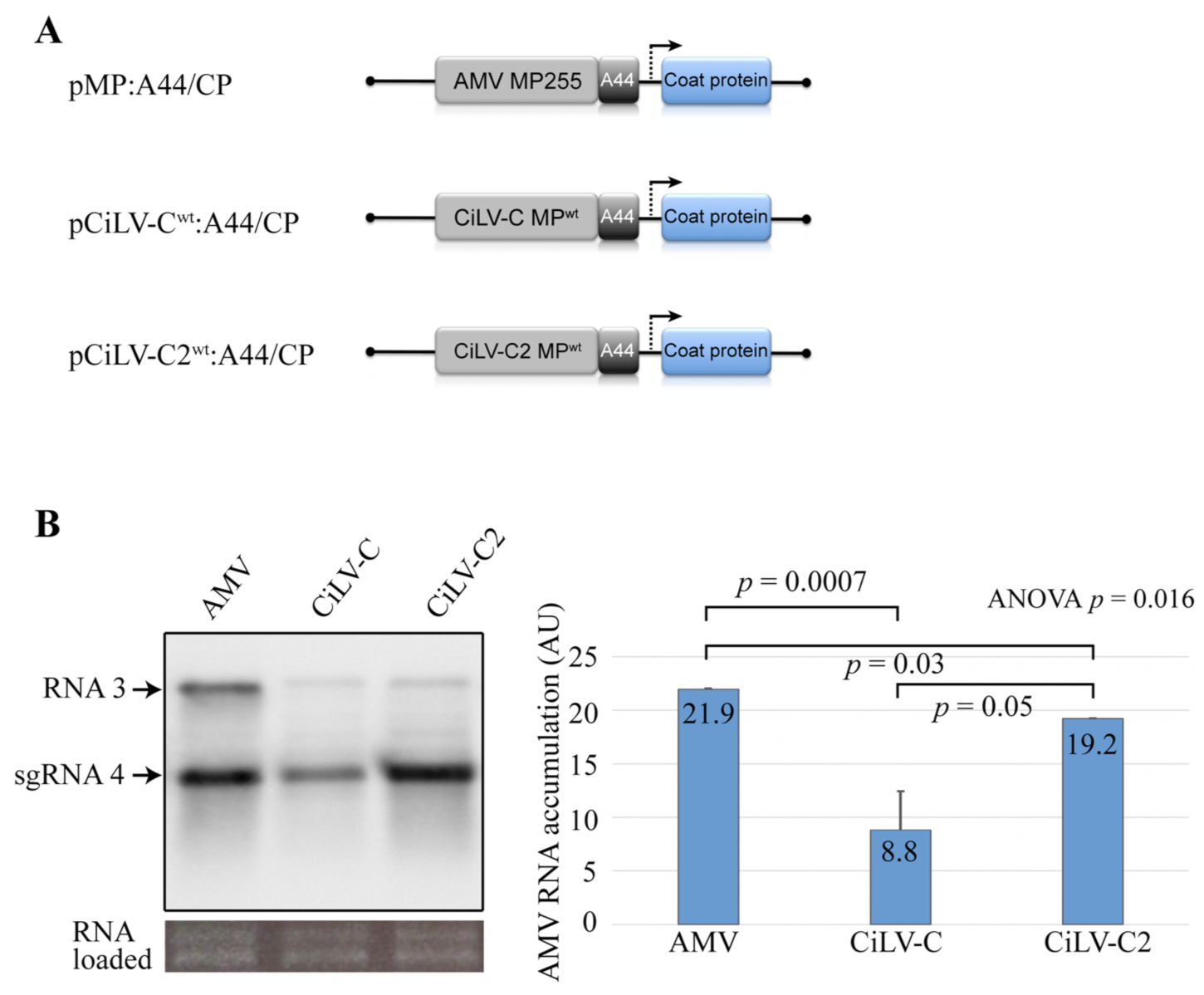
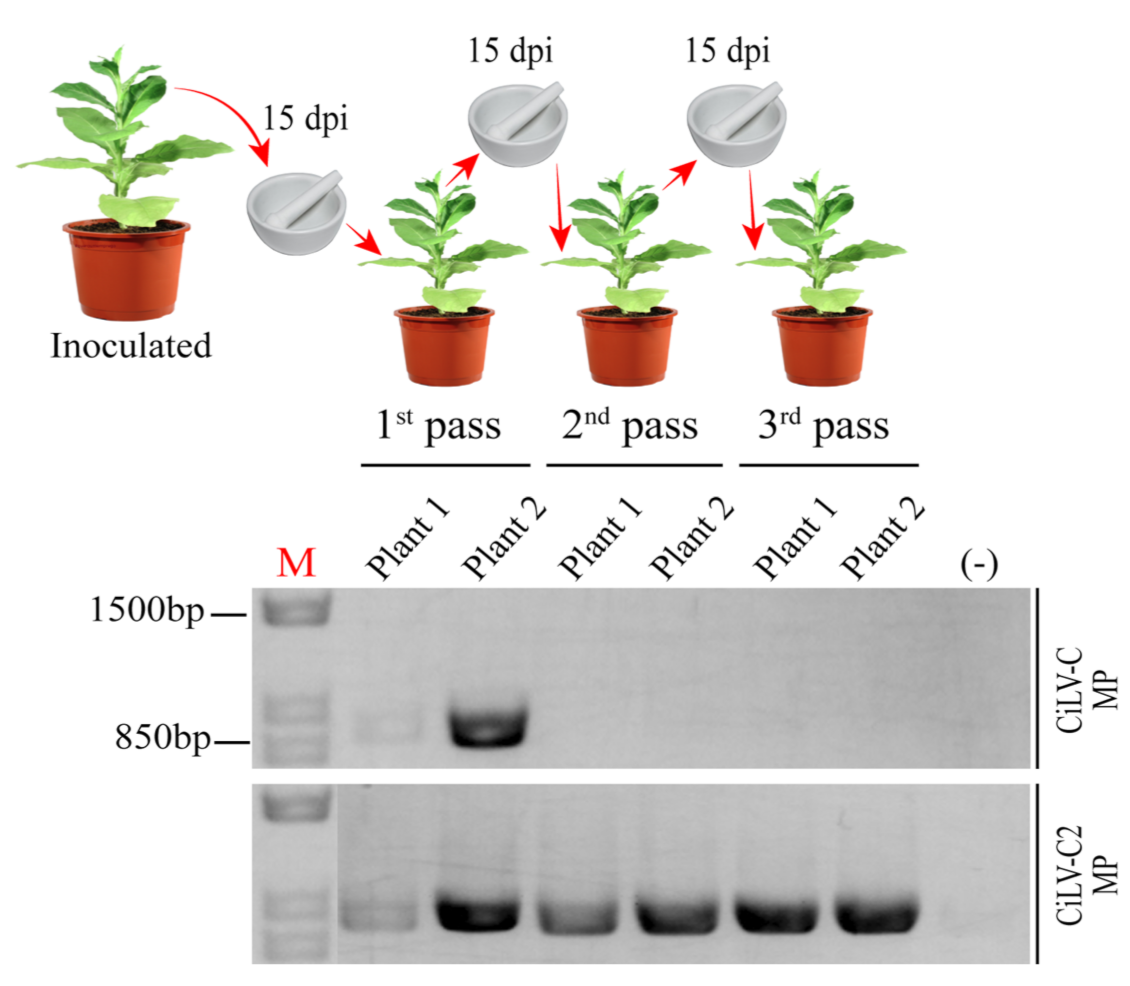
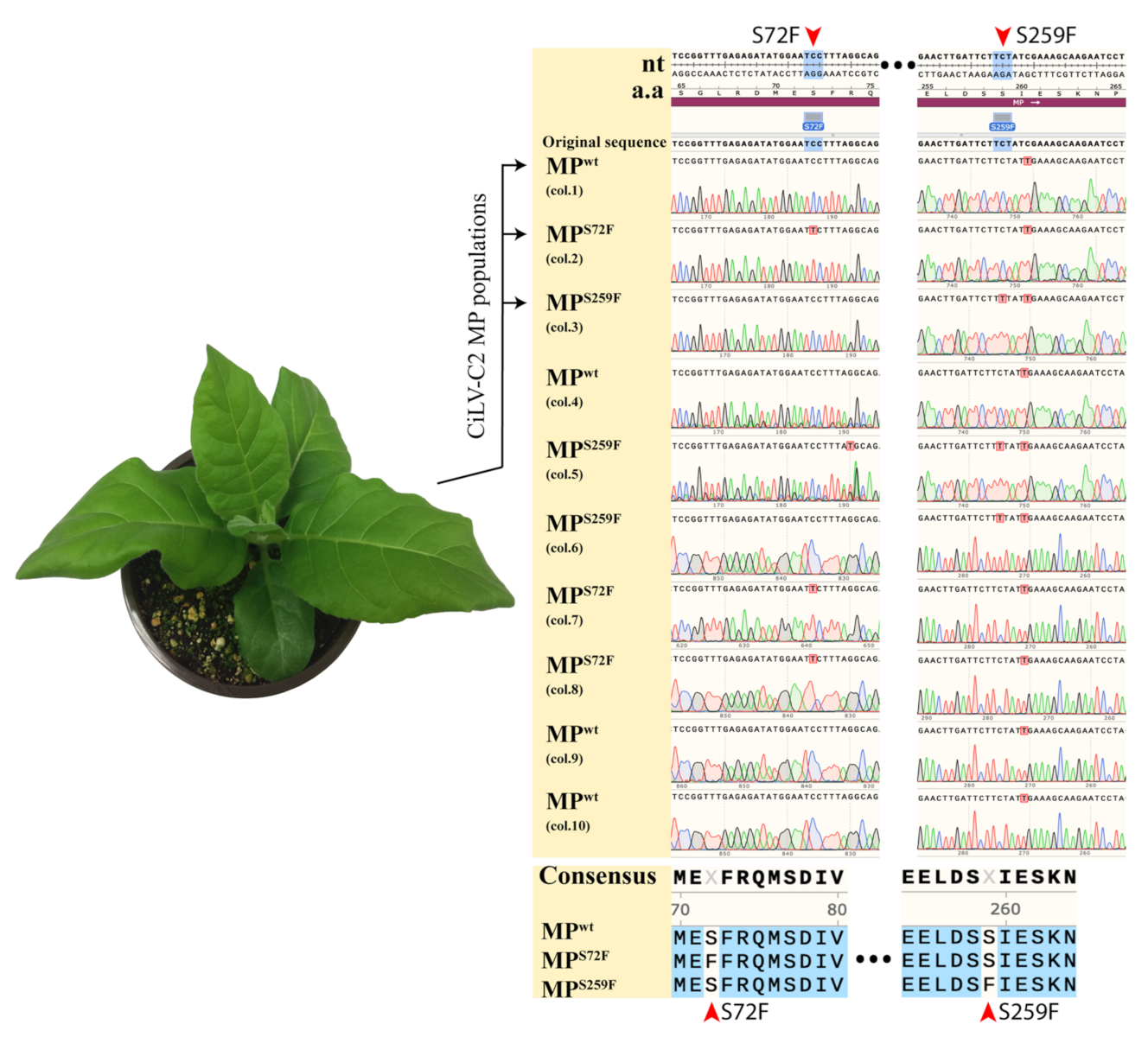
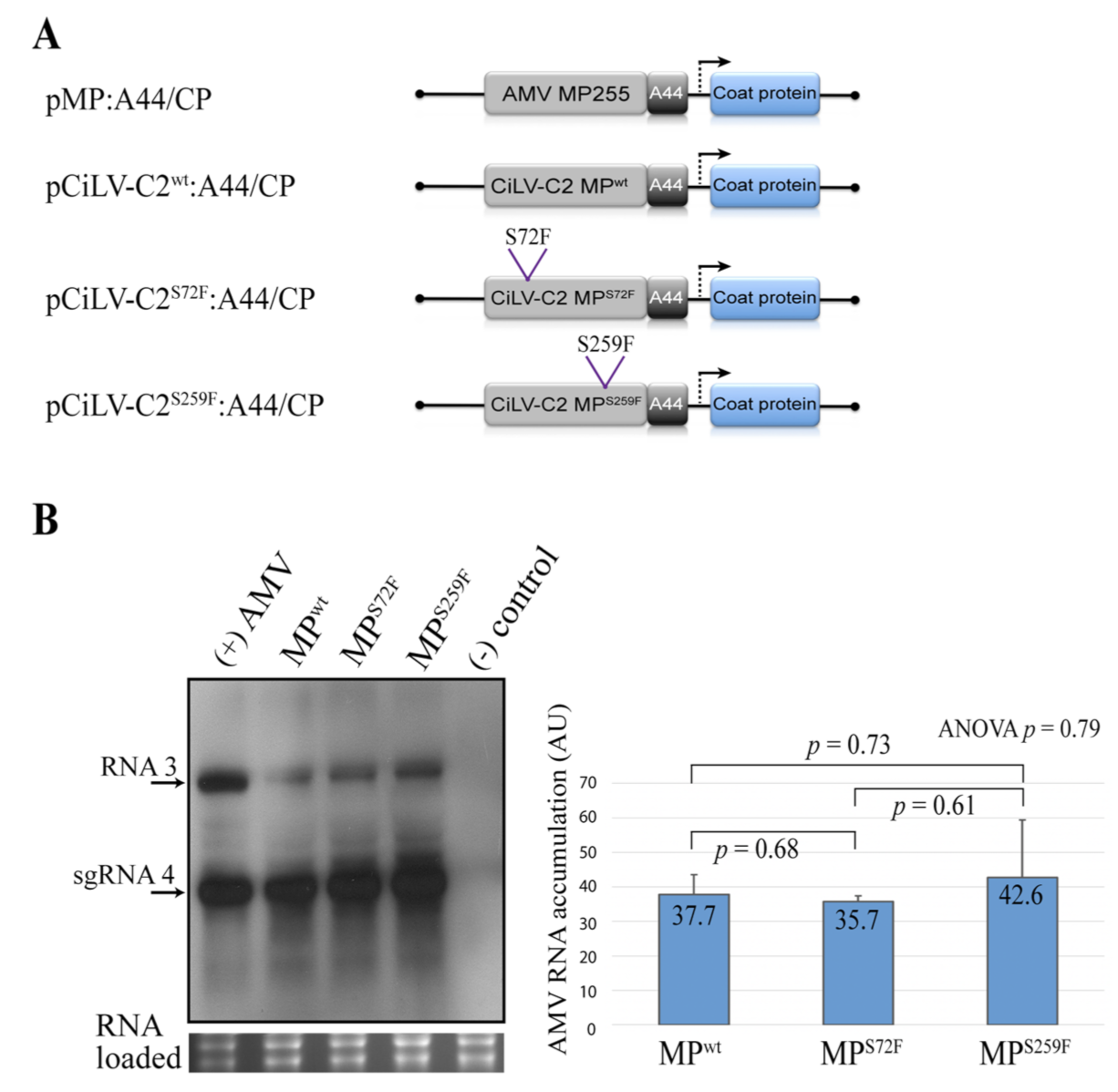
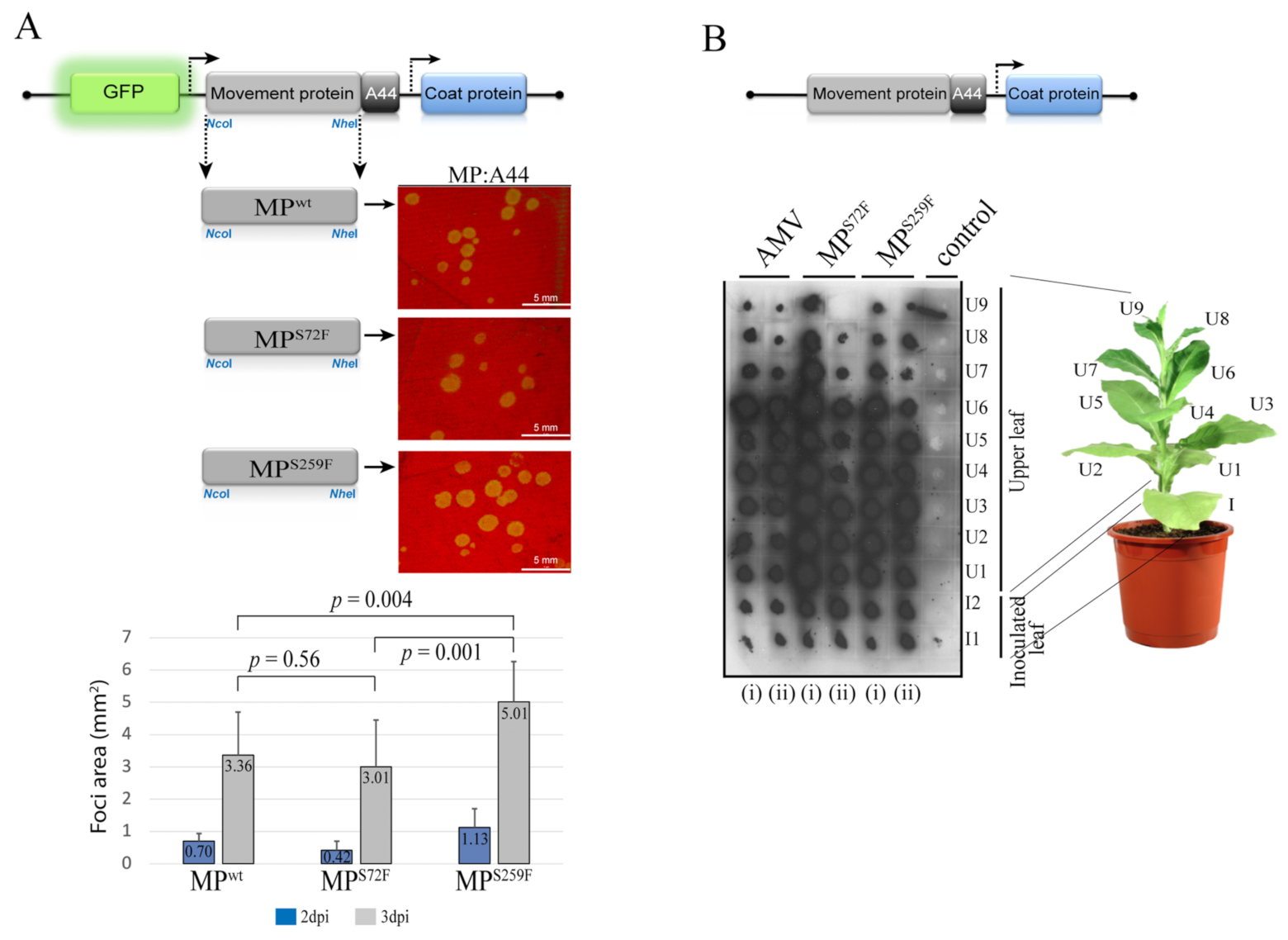
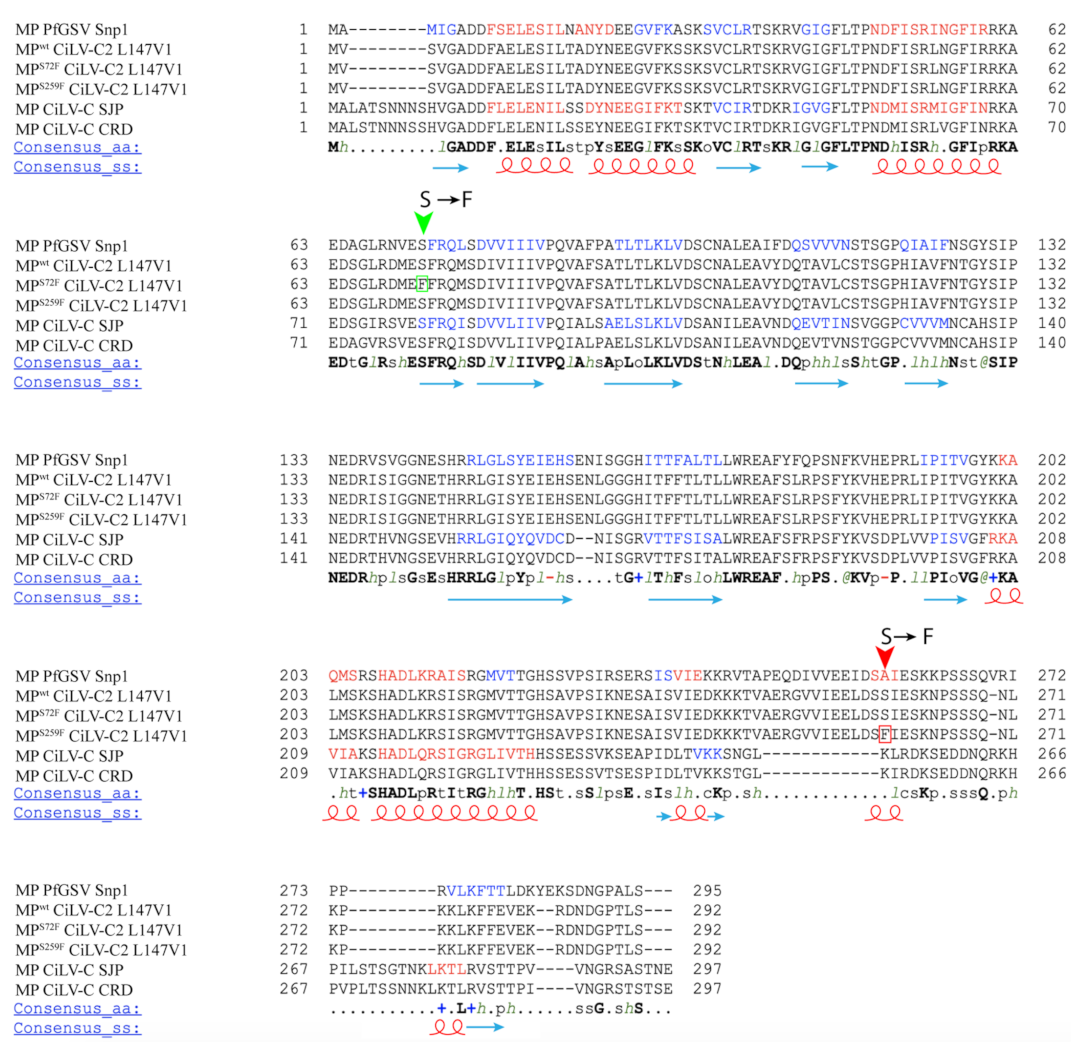
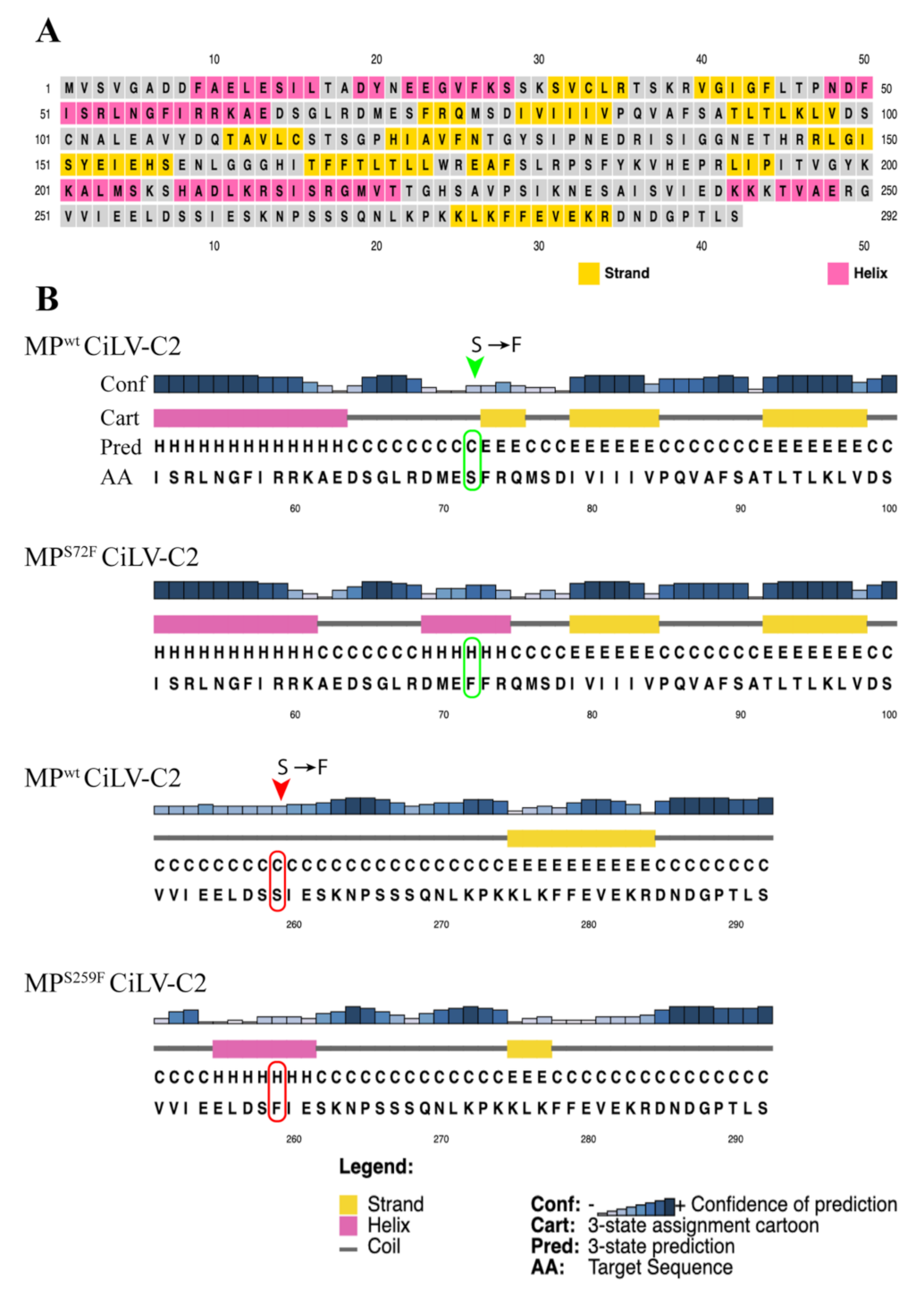
| Viral Inoculum Passage | Repetition | MPWT vs. MPS72F | MPWT vs. MPS259F |
|---|---|---|---|
| 1st passage | plant 1 | MPWT/MPS72F | MPWT/MPS259F |
| plant 2 | MPWT/MPS72F | MPWT/MPS259F | |
| 2nd passage | plant 1 | MPWT | MPS259F |
| plant 2 | MPWT | MPS259F | |
| 3rd passage | plant 1 | MPWT | MPS259F |
| plant 2 | MPWT | MPS259F |
Publisher’s Note: MDPI stays neutral with regard to jurisdictional claims in published maps and institutional affiliations. |
© 2021 by the authors. Licensee MDPI, Basel, Switzerland. This article is an open access article distributed under the terms and conditions of the Creative Commons Attribution (CC BY) license (https://creativecommons.org/licenses/by/4.0/).
Share and Cite
Leastro, M.O.; Villar-Álvarez, D.; Freitas-Astúa, J.; Kitajima, E.W.; Pallás, V.; Sánchez-Navarro, J.Á. Spontaneous Mutation in the Movement Protein of Citrus Leprosis Virus C2, in a Heterologous Virus Infection Context, Increases Cell-to-Cell Transport and Generates Fitness Advantage. Viruses 2021, 13, 2498. https://doi.org/10.3390/v13122498
Leastro MO, Villar-Álvarez D, Freitas-Astúa J, Kitajima EW, Pallás V, Sánchez-Navarro JÁ. Spontaneous Mutation in the Movement Protein of Citrus Leprosis Virus C2, in a Heterologous Virus Infection Context, Increases Cell-to-Cell Transport and Generates Fitness Advantage. Viruses. 2021; 13(12):2498. https://doi.org/10.3390/v13122498
Chicago/Turabian StyleLeastro, Mikhail Oliveira, David Villar-Álvarez, Juliana Freitas-Astúa, Elliot Watanabe Kitajima, Vicente Pallás, and Jesús Ángel Sánchez-Navarro. 2021. "Spontaneous Mutation in the Movement Protein of Citrus Leprosis Virus C2, in a Heterologous Virus Infection Context, Increases Cell-to-Cell Transport and Generates Fitness Advantage" Viruses 13, no. 12: 2498. https://doi.org/10.3390/v13122498
APA StyleLeastro, M. O., Villar-Álvarez, D., Freitas-Astúa, J., Kitajima, E. W., Pallás, V., & Sánchez-Navarro, J. Á. (2021). Spontaneous Mutation in the Movement Protein of Citrus Leprosis Virus C2, in a Heterologous Virus Infection Context, Increases Cell-to-Cell Transport and Generates Fitness Advantage. Viruses, 13(12), 2498. https://doi.org/10.3390/v13122498









